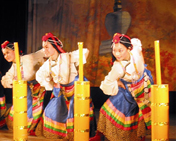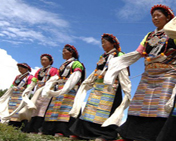Tibeten Folk Music and Dance

Tibetan Music
Tibet stands at the influence of three civilizations, the Turko-Mongolian, the Chinese and the Indian. Enriched from time to time by influences from these, its own ancient tradition has developed in high isolation from the rest of the civilized world. This tradition embraces a very distinctive way of life and a music all its own. Music plays an important part in Tibetan life and has three aspects:
1. Folk music - found in the daily lives of the people; 2. Art music - cultivated especially by professional musicians; 3. Tibetan Buddhism music - centering on the monasteries.

Tibetan Dancing
Almost every Tibetan can sing and dance. They sing anytime for any event and dance at festivals, weddings, gatherings and during their spare time. The Tibetan nationality has a population of about 3.87 million, scattered in Tibet, Gansu, Sichuan and Yunnan, which are known for their highlands, grasslands, thick forests and abundant natural resources. The areas inhabited by Tibetans boats a great diversity of folk songs and dances. From historical writings we can see that more than a thousand years ago folk religious and sorcerers' dances were very popular in Tibet. They influenced the Wild Bull Dance, Yak Dance, Deer Dance, Crane Dance, Peacock Dance, Sorcerers' Dance, Drum Dance and other kinds of folk dances that have been handed down to this day. Some of the early dances popular among Tibetans are Guoxie Dance, Duixie Dance, Guozhuang Dance, Xie Dance, Zhuoxie Dance, Qamo Dance.





 8 Days Nyingchi Shigatse Namtso Tour
8 Days Nyingchi Shigatse Namtso Tour  4-Day Lhasa Join-in Group Tour
4-Day Lhasa Join-in Group Tour  5 Days Lhasa Group Tour with Yamdrok Lake
5 Days Lhasa Group Tour with Yamdrok Lake  5 Days Lhasa Pilgrimage Tour to Ganden Monastery & Drak Yerpa
5 Days Lhasa Pilgrimage Tour to Ganden Monastery & Drak Yerpa  6 Days Lhasa Shigatse Group Tour
6 Days Lhasa Shigatse Group Tour  5 Days Lhasa-Namtso-Lhasa Group Tour
5 Days Lhasa-Namtso-Lhasa Group Tour  7 Days Overland Tour from Lhasa to Kathmandu
7 Days Overland Tour from Lhasa to Kathmandu  8 Days Lhasa-Shigatse-EBC-Group Tour
8 Days Lhasa-Shigatse-EBC-Group Tour  7 Days Central Tibet Group Tour with Namtso
7 Days Central Tibet Group Tour with Namtso  Data in submission...
Data in submission...


